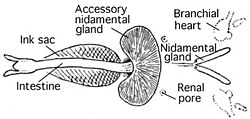
Cephalopod ink is a dark-coloured or luminous ink released into water by most species of cephalopod, usually as an escape mechanism. All cephalopods, with the exception of the Nautilidae and the Cirrina (deep-sea octopuses), [1] are able to release ink to confuse predators. [2]
Contents
- Properties and chemistry
- Attack protection
- Chemical effects
- Physical properties
- Types of ink shapes
- Inking behaviours
- Escape strategies
- Hiding strategy
- Behavior around eggs
- Use by humans
- References
- External links
The ink is released from the ink sacs (located between the gills) and is dispersed more widely when its release is accompanied by a jet of water from the siphon. Its dark colour is caused by its main constituent, melanin. Each species of cephalopod produces slightly differently coloured inks; generally, octopuses produce black ink, squid ink is blue-black, and cuttlefish ink is a shade of brown.
A number of other aquatic molluscs have similar responses to attack, including the gastropod clade known as sea hares.











